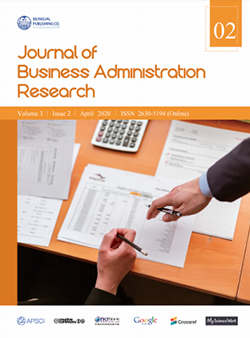An Approach to Find the Point of Buying Stock Based on Big Data
DOI:
https://doi.org/10.30564/jbar.v3i2.1811Abstract
It is a research subject that has attracted a wide concern and study for a long time to find a suitable trading point of stock. From the views of big data and quantization technique, the paper tries to propose an approach, through the form of algorithm, based on big data analysis and linear weighted moving average curve, to find the point of buying stock, so that the trader would like to achieve the expected profit with a higher probability; and makes the digital experiment to further explain the approach and verify its performance. This work can promote the development of big data research and quantization technique, and can also provide a certain reference method for the trader making the technology analysis of the trade.
Keywords:
Stock Big data, Weighted moving average, Algorithm, ProfitReferences
[1] D. W. Tian. An Empirical Study on the Effect of the Split Share Reform on the Effectiveness of China’s Stock Market[J]. Finance & Economy, 2017(04): 144-147.
[2] S. Wang, J. Z. Qiao. Forecasting stock price by Markov Chain:Take Yili Group as the instance[J]. Inner Mongolia Statistics, 2017(04): 7-9.
[3] X. K. Li. Correlation analysis of Shanghai and Shenzhen stock markets based on Copula function[J]. Journal of Shaanxi University of Technology, 2017, 33(06): 75-81.
[4] X. L. Ren, Y. K. Xiao, W. Y. Sun. Volatility Spillover Effect Between International Energy Market and Chinese Stock Market[J]. Journal of Ocean University of China, 2018(06): 65-71.
[5] R. W. Lin, Y. Yang. Stock Market Trend Prediction: Based on Multi-Dimensional Cross-Validation Method[J]. Journal of Shanghai University of Internatinal Business and Economic, 2018, 25(06): 40-49.
[6] X. P. Teng, W. Zheng. Deep Multiple Regression Model for Stock Price Trend Foreca-sting[J]. Economic Research Guide, 2019(21): 71-74.
[7] B. J. Chen, W. J. Chen. Research on Moving Average Analysis and Its Trading Strategy[J]. Commercial Research, 2015(07): 73-79.
[8] B. B. Sun. Are Moving Average Rules Profitable? Evidence from Shanghai Composite Index[J]. The Journal of Quantitative & Technical Economics, 2005(02): 149-156.
[9] C. Y. Wang. Research on the effectiveness of trend investment in Shanghai share market and Shenzhen share market: A strategy based on the moving average[J]. Business Economy, 2019(09): 178-180.
[10] X. X. Xu, L. Z. Wang, C. D. Cheng. A Method of Finding Stock Buying Point Based onMoving Average Price and Big Data Analysis[J]. Statistics and Application, 2020, 9(1): 1-6.
Downloads
Issue
Article Type
License
Copyright and Licensing
The authors shall retain the copyright of their work but allow the Publisher to publish, copy, distribute, and convey the work.
Journal of Business Administration Research publishes accepted manuscripts under Creative Commons Attribution-NonCommercial 4.0 International License (CC BY-NC 4.0). Authors who submit their papers for publication by Journal of Business Administration Research agree to have the CC BY-NC 4.0 license applied to their work, and that anyone is allowed to reuse the article or part of it free of charge for non-commercial use. As long as you follow the license terms and original source is properly cited, anyone may copy, redistribute the material in any medium or format, remix, transform, and build upon the material.
License Policy for Reuse of Third-Party Materials
If a manuscript submitted to the journal contains the materials which are held in copyright by a third-party, authors are responsible for obtaining permissions from the copyright holder to reuse or republish any previously published figures, illustrations, charts, tables, photographs, and text excerpts, etc. When submitting a manuscript, official written proof of permission must be provided and clearly stated in the cover letter.
The editorial office of the journal has the right to reject/retract articles that reuse third-party materials without permission.
Journal Policies on Data Sharing
We encourage authors to share articles published in our journal to other data platforms, but only if it is noted that it has been published in this journal.




 Yao Fu
Yao Fu

